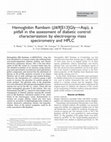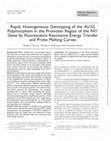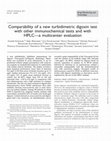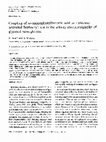Papers by Heinrich Wieland

Neonatology, 2001
Background: Cytokine plasma levels are suggested to be sensitive indicators of neonatal sepsis, b... more Background: Cytokine plasma levels are suggested to be sensitive indicators of neonatal sepsis, but conventional assays are time consuming. This study aimed at evaluating the significance of cord blood levels of interleukin (IL)-6 and IL-8 determined by a fully automated random access assay within 90 min of admission to predict systemic bacterial infection. Patients and Methods: Cord blood levels of IL-6 and IL-8 were determined in 71 mature and 100 premature infants by a chemiluminescence assay (Immulite®). Patients were divided into four groups according to a clinical and laboratory scoring system. Group A: documented early-onset infection; group B: infection possible; group C: infection unlikely, and group D: healthy newborns. Results: Median IL-6 levels in the subgroup of premature newborns were as follows: group A, 1,920 pg/ml (5–95% confidence interval 308–4,660 pg/ml); group B, 50 (15–102) pg/ml; group C, 21 (12–71) pg/ml, and group D, 8 (6–11) pg/ml. For IL-8, median levels ...

Hemoglobin (Hb) Rambam, or b69(E13)Gly3 Asp, has been identified in a German woman also suffering... more Hemoglobin (Hb) Rambam, or b69(E13)Gly3 Asp, has been identified in a German woman also suffering from non-insulin-dependent diabetes mellitus and chronic obstructive pulmonary disease. This is the first obser- vation of this Hb variant in a German family thus far. The detailed evaluation of its structure using electros- pray mass spectrometry revealed new minor glycohemo- globin components and showed that the attachment of glucose to the b NH2 terminus occurred at an almost identical rate in both wild-type and mutant b-chains. However, the introduction of a carboxyl group at b69 seems to increase the glycation of e-amino groups of lysine residues. The glycemic state in the propositus was well reflected by the total glycohemoglobin concen- trations but not by the Hb A1C values, which did not reflect hemoglobin glycation in this patient. This case demonstrates that Hb A1C cannot be used reliably in the management of diabetic patients carrying Hb variants such as Hb Rambam. Functional...

Clinical Chemistry, 1999
Background: Many studies have convincingly shown that survivors of myocardial infarction have imp... more Background: Many studies have convincingly shown that survivors of myocardial infarction have impaired fibrinolytic activity because of increased concentrations of plasma plasminogen activator inhibitor-1 (PAI-1). A single guanosine insertion/deletion polymorphism in the promoter region of the PAI1 gene, commonly called 4G/5G, has been shown to be associated with plasma PAI-1 activity. Our aim was to develop and validate a homogeneous assay for rapid genotyping of the 4G/5G polymorphism.Methods: In this report we present a single-tube method for genotyping of the 4G/5G polymorphism that combines both rapid-cycle PCR with real-time monitoring of the amplification process and generation of allele-specific fluorescent probe melting profiles on the LightCyclerTM. Two fluorescently labeled hybridization probes recognizing adjacent sequences in the amplicon were present in the reaction mixture. The shorter detection probe spanned the polymorphic site, perfectly matching the 5G allele. Aft...

Clinical Chemistry, 1997
A new turbidimetric inhibition immunoassay for digoxin (Tina-quant® □a Digoxin, Boehringer Mannhe... more A new turbidimetric inhibition immunoassay for digoxin (Tina-quant® □a Digoxin, Boehringer Mannheim) was evaluated in seven laboratories. It can be performed without sample pretreatment with ready-to-use reagents on nondedicated analyzers in combination with routine clinical chemistry. The studies revealed a good analytical performance: lower limit of detection 0.12 μg/L (3 SD from mean of blank); linearity up to 7.5 μg/L; median between-run CVs 8.1% (0.6 μg/L), 2.8% (1.5 μg/L), 1.9% (3 μg/L); mean analytical recovery in control sera 98–102%; slopes from 0.97 to 1.09 and intercepts from −0.28 to 0.10 μg/L in comparison with four immunoassays; and a high resistance to common interferents. The test was more resistant to digoxin-like immunoreactive factor (DLIF) interference than other methods, showing cross-reactivity only in some intensive care patient samples. Among 192 patients in whom DLIF is expected (e.g., pregnant women, patients with renal failure, newborns), 90% of results we...
Rapid Cycle Real-Time PCR, 2001

Journal of Chromatography B: Biomedical Sciences and Applications, 1992
An improved process is described for covalent coupling of m-aminobenzeneboric acid to s-triazine-... more An improved process is described for covalent coupling of m-aminobenzeneboric acid to s-triazine-activated Sephacryl matrices. The derivatized Sephacryl gel contained up to 150-200 pmol boronate per ml. It has been applied to the separation of glycated and non-glycated hemoglobins (Hbs) present in red-cell hemolysate. The new bioaffinity support was evaluated by the analysis of 67 diabetic patients and 20 normal adults. The mean value for glycated Hb was 6.6 f 0.8% for non-diabetics and 11.2 f 2.9% for diabetics. The method effects group-specific separation between glycated and non-glycated Hbs even in presence of foetal Hb and abnormal Hb variants. There is an excellent correlation between the glycated Hb levels obtained by the new method and two established procedures, namely high-performance liquid chromatography (r = 0.933) and affinity Merckotest (r = 0.991). The inter-assay and intra-assay coefficient of variations of less than 3.0% suggest that the method is reproducible. The results indicate that the method may serve as an alternative procedure for the study of glycated proteins. The s-triazine-activated Sephacryl could also be used for immobilizing enzymes and for preparing biospecific absorbents.











Uploads
Papers by Heinrich Wieland